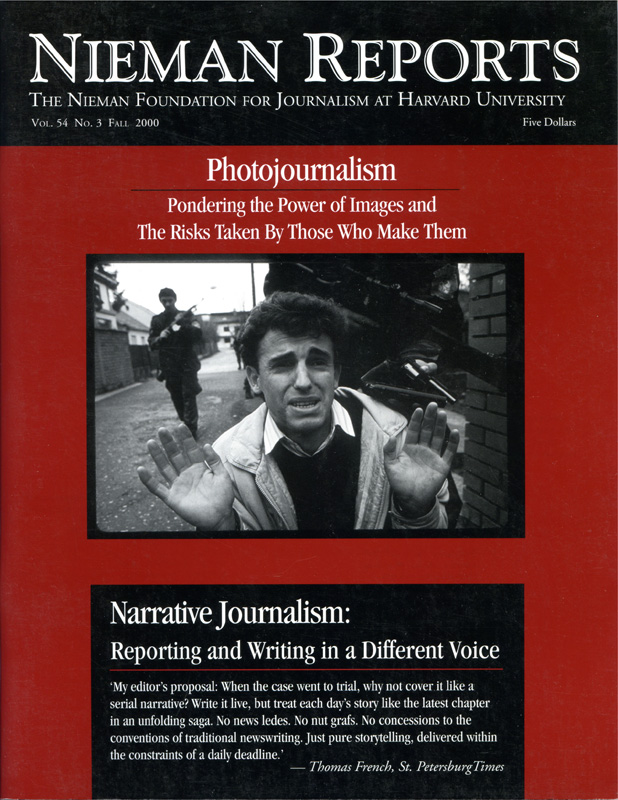James Nachtwey’s book “Inferno” is a collection of 382 photographs depicting the horrific brutality and suffering of people who are entrapped by war, famine or political unrest. Its publication offers an opportunity to reflect not only on his extraordinary and courageous career as a photojournalist but on how, in this time of visual onslaught, images such as these are absorbed and their messages acted upon.
In his Los Angeles Times review of “Inferno,” David Rieff, co-editor of “Crimes of War: What the Public Should Know,” challenged those who view Nachtwey’s photographs to consider the following: “…whether the level at which photographs touch their viewers, which as Nachtwey points out is ‘more visceral, more elemental, closer to raw experience,’ is one that really gives them the information they need to make the political judgment in order to mitigate the horrors Nachtwey’s pictures chronicle… [T]here is something dangerously simplistic about simply demanding a response to the sufferings of victims without specifying what that response should be.”
Several writers and photographers consider this question, among others, in essays that accompany images taken by Nachtwey and others photojournalists. Nachtwey’s views are heard in quotes excerpted from interviews.* Photographer Michele McDonald (’88 NF) reviews “Inferno,” calling it “the most unbearable book I have ever looked through.” Images of death and terror still inhabit the dreams and wakefulness of Steve Northup (’74 NF), who covered the Vietnam War as a UPI staff photographer. Yet he deplores the relative absence of such photographic images now due to Pentagon policy and journalistic compliance. “We have sanitized war, or its images…this is a terrible disservice to all of us….” Novelist Philip Caputo, who as a foreign correspondent covered several major conflicts, finds no reason why those who photograph war need to justify the images they send home. Imparting information, he believes, ought to be enough.
Brent Staples, writing in the Editorial Observer column in The New York Times, described his reaction to seeing an exhibition of lynching photographs. “There is an unbearable measure of horror here,” he wrote, “that I have no interest in learning to endure.” His unwillingness to look long at these images led him to conclude: “With these horrendous pictures loose in the culture, the ultimate effect could easily be to normalize images that are in fact horrible.”
Three war photojournalists then describe—in words and photographs—what it is like to do their jobs on the frontlines of ethnic struggles in a panel discussion sponsored by The Crimes of War Project and The Freedom Forum. “Basically we’re alone,” said Ron Haviv, “left up to our own wits.” Mary Kay Magistad (’00 NF), formerly National Public Radio’s Beijing correspondent, writes about her friend, journalist Kurt Schork, his death by snipers in Sierra Leone, and the risks journalists take to cover war. And former Royal Marines talk about how they teach journalists to be safer while reporting conflicts.
*Quotes are from interviews Nachtwey gave to the Lehrer NewsHour, The Boston Phoenix, The Capital Times, and the Dartmouth Alumni magazine. Excerpts were also taken from the Afterword he wrote for “Inferno.”
In his Los Angeles Times review of “Inferno,” David Rieff, co-editor of “Crimes of War: What the Public Should Know,” challenged those who view Nachtwey’s photographs to consider the following: “…whether the level at which photographs touch their viewers, which as Nachtwey points out is ‘more visceral, more elemental, closer to raw experience,’ is one that really gives them the information they need to make the political judgment in order to mitigate the horrors Nachtwey’s pictures chronicle… [T]here is something dangerously simplistic about simply demanding a response to the sufferings of victims without specifying what that response should be.”
Several writers and photographers consider this question, among others, in essays that accompany images taken by Nachtwey and others photojournalists. Nachtwey’s views are heard in quotes excerpted from interviews.* Photographer Michele McDonald (’88 NF) reviews “Inferno,” calling it “the most unbearable book I have ever looked through.” Images of death and terror still inhabit the dreams and wakefulness of Steve Northup (’74 NF), who covered the Vietnam War as a UPI staff photographer. Yet he deplores the relative absence of such photographic images now due to Pentagon policy and journalistic compliance. “We have sanitized war, or its images…this is a terrible disservice to all of us….” Novelist Philip Caputo, who as a foreign correspondent covered several major conflicts, finds no reason why those who photograph war need to justify the images they send home. Imparting information, he believes, ought to be enough.
Brent Staples, writing in the Editorial Observer column in The New York Times, described his reaction to seeing an exhibition of lynching photographs. “There is an unbearable measure of horror here,” he wrote, “that I have no interest in learning to endure.” His unwillingness to look long at these images led him to conclude: “With these horrendous pictures loose in the culture, the ultimate effect could easily be to normalize images that are in fact horrible.”
Three war photojournalists then describe—in words and photographs—what it is like to do their jobs on the frontlines of ethnic struggles in a panel discussion sponsored by The Crimes of War Project and The Freedom Forum. “Basically we’re alone,” said Ron Haviv, “left up to our own wits.” Mary Kay Magistad (’00 NF), formerly National Public Radio’s Beijing correspondent, writes about her friend, journalist Kurt Schork, his death by snipers in Sierra Leone, and the risks journalists take to cover war. And former Royal Marines talk about how they teach journalists to be safer while reporting conflicts.
*Quotes are from interviews Nachtwey gave to the Lehrer NewsHour, The Boston Phoenix, The Capital Times, and the Dartmouth Alumni magazine. Excerpts were also taken from the Afterword he wrote for “Inferno.”



